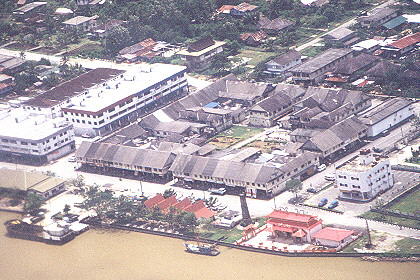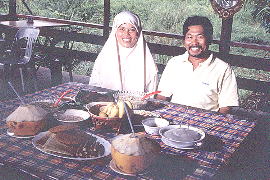 |
 |
It was a hot, hot day. A day made just for sitting in the shade of a thatched beachside cafe, drinking in the breeze rolling in like cool sighs from the breaking waves. One such cafe exists at the Pantai Harmoni Resort, in the coastal town of Mukah.
 | A couple of things make it different from all other such establishments around the world. It is the first and, for the moment, the only one in Mukah. More significantly, it has a particularly unique and delightful item on its menu for a day like this - umai, a local fish dish so refreshingly light and tangy it seemed the perfect complement to the sunshine and sea winds. |
Considering that umai is a traditional working lunch for the Melanau fishermen, the notion isn't that far fetched. It is made mainly of thin slivers of raw fish, thinly sliced onions, chilli, salt and the juice of sour fruits like lime or assam. It is usually accompanied by a bowl of toasted sago pearls instead of rice. Its simplicity makes it a cinch for fishermen to prepare it aboard their boats. Even local landlubbers, hankering for a taste of it, head for this cafe. Umai is uniquely associated with the Melanau people, for whom Mukah is the heart of their traditional lands.
| The Melanau, well-known as fisherfolk and sago cultivators, have traditions that can literally be tasted in foods like umai. In fact, the more my friend and I discovered of their food, the more we learned about the people. Like our first taste of home-cooked Melanau food, at the village of Kampong Tellian Ulu, where lunch was the natural extension of gracious Melanau hospitality. |  |
Curiosity about them and their culture led to an introduction to Penghulu (Chief) Jack Maya of Kampong Tellian Tengah, a Christian community - which in turn led us to Tua Kampong Petalan Labai, head of the pagan village of Tellian Ulu. This was also our first close encounter with this ethnic race and it was an eye-opener. Their lives are still much tied to the sago palm, a tree which thrives like a weed in their coastal country. The house we were in, set under a stand of sago palms at the edge of a stream, was raised high on stilts to protect it from the tidal waters. The stream was one of many that weaves its languorous coils across Mukah's coastal plains.
  | People still travel on them in small dugouts or tow rafts of sago trunks lashed together, to be processed at nearby sago factories. Wooden walkways connect houses to one another and to the main roads, echoed above by strands of electric cables that power fans and televisions in homes. Sago plantations are familiar sights from the walkways and windows of many houses. We were entertained in the spacious hall of a cheerfully painted house, with linoleum on the floor and simple curtains on the windows. There were family portraits framed and hung on the wall, mostly of wedding occasions. Signs of the family's Christian faith hung beside them. |
A little refreshment was served - an orange syrup, bananas and fragrant sago and coconut wafers called tabaloi. We learnt that sago plantations are notoriously easy to keep as they need little care. When a tree is ready for harvesting it is cut, sparing the young suckers that sprout from its base. These will form the next harvest, so no tilling or replanting is necessary. We learnt that sago plantations are notoriously easy to keep as they need little care. Petalan Labai, gathered several examples to show how sago was used in the lives of the Melanau.
| There was a collection of baskets, brooms, backpacks, fish traps, and even sago pith figures made for pagan healing rites. A unique, pivoting bucket system for scooping water was also brought out. It was made of sago and bamboo. Its design has not been improved even with the mechanisation of sago production, in which the bucket is heavily used. A very amused Penghulu Jack took it down to the stream and demonstrated how it worked. His grin grew even wider as he showed us another Melanau specialty - sago grubs, or siat, found in sago stumps. The grubs were fat, white and about long, with a dark brown head. From what looked like a basket writhing with many squirming siat, Penghulu Jack picked one grub and popped it into his mouth. I watched in bug-eyed silence and fascination as the pleasure of it spread over his face. The taste of the live grub, according to a 1969 article on Bornean cooking in the Sarawak Museum Journal, is described as "better than umai." Apparently, part of the appeal lay in way the grubs "convulsed," and also in the "'good burst' when crushed by the teeth." Maybe it was my urban upbringing, but my mind flipped with my stomach. I declined the invitation to try the highly-prized delicacy. If I thought that was to be the end of the matter, I was wrong. The remaining siat surfaced at lunch, lightly fried and served in a dish on the dining table. My long-sighted friend, without his glasses, mistook them for stir-fried meat and ate one. Fortunately, there were other options. On the table too were salted fish, some greens, rice, sago pearls and that yet unfamiliar dish - umai. |    |
Try it, they encouraged. I was hit by its unexpectedly delicate yet spicy flavour. "Raw fish," explained someone. And I had a suspicion they were holding their breath, waiting for my reaction. Raw fish or not, I couldn't get enough of it. Perhaps if the siat had been just as well disguised, I might have fallen in love with that too. Seeing my enthusiasm, Penghulu Jack showed the proper way to enjoy it with a handful of sago pearls tossed into the mouth by hand. Now, sago pearls can be tricky things. If you don't scoop then up from the bowl carefully, they get caught between your fingers. And when you toss them into your mouth, some will decide on a different destination.
 | I had sago pearls bouncing off me, the table, the floor, and down my shirt. Another thing about them is that they are very dry, and when you bite them, they crumble into a fine powder. It doesn't pay to breathe in too deeply when chewing them. If my hosts were amused by my exhibition at the table, they were far too polite to let on. |
Apart from feeling like some clumsy country fool next to them, I had a great time. On the way back, we passed a van advertising a resort in Mukah. When you're this far off the beaten track, it's something that just begs to be checked out. We tailed it and were pleasantly surprised to arrive at an informal collection of six air-conditioned chalets and a dormitory longhouse within a stone's throw from a beach.
| Pantai Harmoni (Harmony Beach) Resort is owned by Hussien and Dayang Latifah, a local couple who started it to accommodate visiting friends and relatives. After several satisfying experiences with guests who enjoyed it as a weekend and holiday retreat, they decided to make a business of it in 1991. |  |
The entire venture, tells Hussien with some pride, has been self-financed. I was especially pleased to discover that they had a cafe that served umai. As well as other traditional Melanau specialties that could be prepared on request. The cafe came as a natural extension of the enterprise, and I was delighted by a spontaneous invitation to sample some home-cooked Melanau food. Dayang Latifah laid out quite a spread among which, I was glad to note, was some umai! Dining became a relaxed affair with as much food as conversation.
 | We found out that her father-in-law, a retired fisherman, helps ensure a steady stock of filleted and sliced fish served for umai. She also gave an insight into other Melanau food. She tells that while the Melanau eat more rice today, they still enjoy their traditional staple in many forms. |
Sago is taken in other forms besides the sago pearls they call sagok. There is also linut, a thick, translucent paste that has to be eaten hot. Eating it the traditional way means coming to grips with a whole new eating technique. It is picked up by twirling a bent bamboo skewer in the gummy paste till a fair-sized blob is caught on the ends of the stick. This is then dipped into sasah, a deliciously spicy pepper sauce. Then there is tetupek, a dry mixture of sago flour and ground coconut that looks like buff-coloured rice grains. This is also eaten dry, like sagok, with other foods such as barbecued stingray, or ikan pejah.
|
Sago flour is also made into several kinds of biscuits such as Tabaloi layah, the aromatic sago and coconut wafer I had tasted earlier at Kampong Tellian Ulu. Another is tabaloi gulong, made into biscuit sticks. Not all Melanau desserts involve sago. Linkiang balek and linkiang pelutan are smoked banana and jack fruit, both the fruit being commonly grown in local gardens. |  |
Unlike the Christian and pagan Melanau we had met earlier, Hussien and his wife were Muslims. On this particular occasion during the Muslim fasting month, there is a Melanau version of a spicy porridge served only during this period. It was called bubor pediah. Dayang Latifah also served a stew of yam stems or sayor bunkou, and a starter of an exotic local legume called kachang belibit, eaten raw with sambal belachan - a chilli paste with lime and shrimp. Fruits can also be had with the sambal, and this style of eating is known asbarulam. Barulam was often had whenever groups gathered, and gossip was as much a part of the fare as the home-grown or wild fruit and vegetables. These dishes are part of an unwritten menu available on request. For a small town in rural country way off the beaten trail, Pantai Harmoni's offering of sunset and a Melanau dinner is a rare thing. Should you happen to find yourself there on a hot, hot day, though, be certain to try their umai.
| The Kelabit Connection | Footloose In Sarawak | Pun Ritai's Home Page |

(Updated on 17th April 1998)